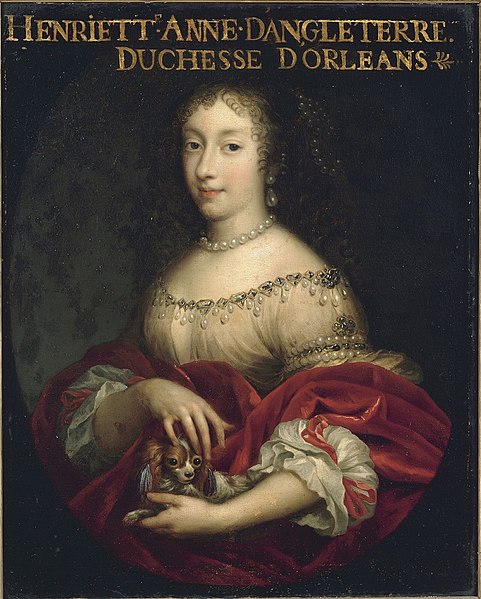
Henriette Anne, sister of King Charles II of England had a unique destiny. Born during the tense times of the English Civil War, she would never know her father and grew up in exile in France with her mother. Even though she was English, she would come to be thoroughly French, marrying the brother of King Louis XIV. Henriette Anne would take part in a voluminous correspondence with her brother and serve as ambassador, advisor and negotiator for the most important Anglo-French treaty of her time.
Queen Henrietta Maria was pregnant. Parliamentary forces had increased in strength and civil war raged around Oxford. Shortly before the Battle of Newbury, King Charles I urged his wife to look for a safer and quieter haven. The Queen said goodbye to her husband for the last time and made her way to Exeter to Bedford House where she gave birth to Henrietta on June 16, 1644. It was a difficult birth. Henrietta’s left shoulder would be higher than her right and her physical health would be delicate for the rest of her life.
At the insistence of her husband, Henrietta was baptized into the Church of England at Exeter Cathedral. The Queen was sick and weak, fearful she would fall into the hands of the king’s enemies. She made the decision to escape to France, the land of her birth. She sailed on July 14th, leaving Henrietta in the hands of Anne Villiers, wife of Robert Douglas, Lord Dalkeith. Lady Dalkeith was a relative of the Duke of Buckingham. She would take her duties as governess very seriously and kept Henrietta safe.
In late 1645, Exeter was besieged by the army of Parliament and the city surrendered in April 1646. Lady Dalkeith took Henrietta to Oatlands, acting against the instructions of Parliament. They had issued orders for Henrietta to join her brother Henry and sister Elizabeth at St. James Palace. Lady Dalkeith donned a disguise and fled to France. Henrietta was reunited with her mother who was determined to bring her up as a Catholic, knowing her husband had forbidden it.
While Henrietta was in Paris, Anne was added to her name. This was in tribute to Anne of Austria, the widowed queen of Louis XIII and mother of Louis XIV. She was now known as Henriette Anne. The Queen and her daughter were welcomed in France, given rooms in the Louvre and access to the country house of Saint-Germain and a pension of thirty thousand livres. However, the Queen sent most of her money and proceeds from the sale of her plate and jewelry to her husband in England. Slowly the pomp and comforts diminished for her and her daughter.
Many of the cavaliers who were supporting her husband came to the Queen’s home in France as an informal meeting place. The Prince of Wales, her eldest son Charles came in September 1646. At this time Henriette Anne was just over two years old and Charles didn’t have much time for her. He left to take command of the Royalist fleet and civil war broke out in France. During the Fronde, Paris was under siege and the Queen and Henriette Anne were virtually prisoners in the Louvre during the tumult.
King Charles I lost his battle with the parliamentarians, was tried and convicted and executed by beheading on January 30, 1649. Oliver Cromwell ruled the Commonwealth of England as a republic. Henriette Anne’s brother Charles was now king of England but he was in exile and struggled to reclaim his throne. With the French civil war coming to a close, Henriette Anne began to make her mark at the French court, appearing in a ballet in early 1654. She played the harpsichord and danced very well. She soon became a favorite, especially with Anne of Austria. Her mother wanted Henriette Anne to marry Louis XIV but Louis and his minister Cardinal Mazarin had other ideas.
Henriette Anne was the only child Queen Henrietta Maria was able to completely mold. She was the most popular member of the Stuart family and she demonstrated a natural grace allowing her to adapt to any kind of company. She endeared herself to everyone she met, being sweet-natured and open-hearted. She had the rare quality of charming both men and women, with the capacity to both give and receive love. She was intelligent, affectionate and loyal. There are several surviving descriptions of her by people who knew her personally.
Her brother Charles would visit her for the first time in five years in 1659. She had changed so much he hardly recognized her. She had a doll-like figure, brilliant coloring, bright chestnut hair and beautiful blue eyes. Her skin was described as ‘rose and jasmine’ and her teeth were white and straight, giving her a brilliant smile. After ten days together, Charles fell under her spell, and despite the fourteen-year difference in their ages, they became mutually devoted to each other from that point forward. Charles may have acted in the capacity of a father for Minette, his pet name for his favorite sister.
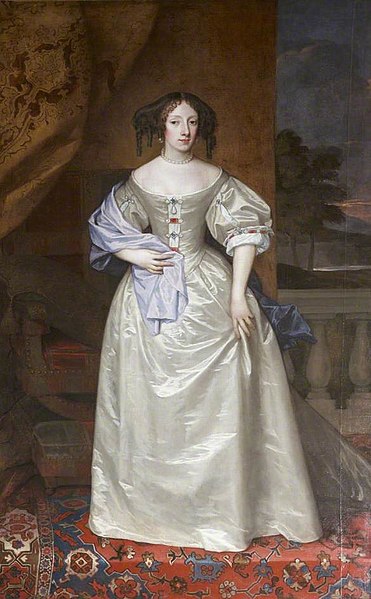
Their attraction was immediate, mutual and total and they began a correspondence that would last until Henriette Anne’s death. Even though Charles urged her to write in English, she had little confidence in the language and wrote nearly all the letters in French.
Charles’ visit to France occurred after the death of Oliver Cromwell but before his Restoration to the throne. Following delicate negotiations, it was agreed Charles would return to England and be crowned King. On his birthday, May 29, 1660, he made his entry into London. Before this, the potential for a good marriage for Henriette Anne was limited. Her brother’s Restoration changed everything and her most significant admirer was Louis XIV’s younger brother Philippe, duke of Anjou.
Anne of Austria knew what a threat a younger brother to the king could be. She had to put up with the machinations of Louis XIII’s brother Gaston, duke of Orléans. Therefore, she did everything in her power to make sure Philippe would pose no threat. She brought him up in the company of women and girls. He acquired a taste for dressing in women’s clothes and wearing makeup.
Philippe declared he was in love with Henriette Anne. Louis, Anne of Austria and Cardinal Mazarin approved of the marriage. Queen Henrietta Maria felt it was the best match for her daughter and Henriette Anne seemed to agree. A papal dispensation was needed because the couple were first cousins and this delayed the marriage. At the end of 1660, Queen Henrietta Maria and Henriette Anne traveled to England.
Her brother James, Duke of York had made an inappropriate marriage to a commoner, Anne Hyde, daughter of Charles II’s chancellor. The Queen was determined to dissolve the marriage but Anne Hyde was pregnant and Charles insisted the marriage was valid. While the women were in England, Henriette Anne’s sister Princess Mary and brother Henry, Duke of Gloucester died of smallpox. The English Parliament gave Henriette Anne £10,000 as a wedding gift.
The Queen and Henriette Anne left England to return to France. The weather was vile and their ship had to return to Portsmouth where Henriette Anne became ill with the measles. Eventually, they arrived in France and the wedding took place in March of 1661. King Louis had given the title of Duke of Orléans to Philippe and he was generally known as Monsieur which was the traditional name for the younger brother of the King of France. Henriette Anne would therefore be called Madame.
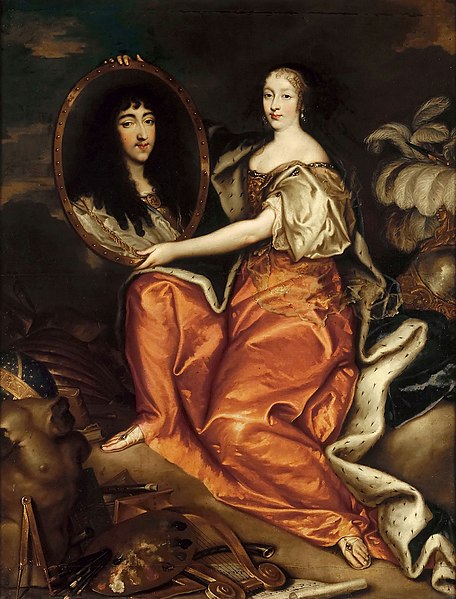
The English chronicler Bishop Burnet described Philippe as ‘a poor-spirited and voluptuous prince; monstrous in his vices and effeminate in his luxury in more senses than one. He had not one good quality, but courage; so that he became both odious and contemptible.’ He was a cross-dresser and bisexual. He claimed he no longer loved Madame after two weeks of marriage. However, the couple maintained regular marital relations at first and Madame had several pregnancies which would take their toll on her health.
Her first daughter, Marie Louise was born in 1662. She would survive and marry Charles II, the last Habsburg ruler of the Spanish Empire. A son Philip Charles was born in 1664 but only lived for two and a half years. There were two stillborn children in 1665 and 1667. Her last daughter Anne-Marie, born in 1669, married Victor Amadeus II, Duke of Savoy and future King of Sardinia.
Henriette Anne had a young Englishwoman in her household named Frances Stuart. She agreed to send Frances to England to become a member of the household of Charles’ new Catholic, Portuguese queen, Catherine of Braganza whom he married in 1662. Frances was a great beauty and Charles tried many times to seduce her. She has the distinction of being one of the few women, if not the only woman, to refuse his advances. She eventually eloped with the Duke of Richmond which infuriated Charles. Henriette Anne would supply relics and holy objects for his Queen Catherine at Charles’ request.
As the love of her husband evaporated, King Louis found Madame was great company. They were almost certainly not lovers but she acted as a confidante for the king. When Madame sought the company of other more convivial men, Philippe would become offensively jealous. He had her closely watched and sometimes removed her from court.
The situation took a significant turn for the worse when Philippe became fanatically obsessed with the chevalier de Lorraine. Lorraine did everything in his power to turn Monsieur against Henriette Anne. The relations between husband and wife became untenable. Henriette Anne turned to King Louis for help and Lorraine was banned from court which only enraged Monsieur that much more. He eventually stopped all marital relations with Henriette Anne and generally made her life miserable. All of this made her thinner, and frailer with a tendency to fainting at even the smallest effort.
Henriette Anne’s mission was to foster amiable relations between England and France and maintain papal allegiance. She served as Charles’ confidant, intermediary and advisor in French affairs for the first ten years of his reign. King Louis enjoyed her company, admired her intelligence and appreciated her undisputed influence on her brother. Charles had long sought an alliance with France, considering this as a counterbalance against the Dutch republic.
Louis had ambitions to take over the Spanish Netherlands. His relations with Charles had deteriorated due to disputes over money, protocol and sovereignty over the narrow seas. Charles declared war on the Dutch in 1665 and due to Louis’ alliance with the Dutch, he was forced to declare war against England. In 1668, England, the Dutch, and Sweden signed a triple alliance, the main purpose of which was to limit the extension of French influence in the Spanish Netherlands.
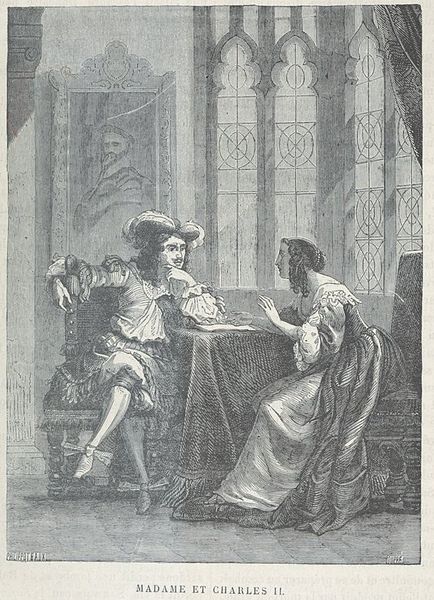
Charles again made clear he wanted an alliance with France and by the fall of 1668, Charles and Madame were discussing a treaty in their letters. Charles felt that his commitment to convert to Catholicism was critical to the negotiations and held a private meeting of only four confidants in January 1669 to confess his intention to do so. In November, Louis was informed of all the English proposals, including Charles’ religious conversion. At this point, Henriette Anne was the most important English negotiator in Paris.
There was one last issue to be concluded. Louis wanted war against the Dutch to start followed by Charles’ declaration of converting to Catholicism. Charles allegedly wanted the announcement to come first. Louis decided Henriette Anne must meet face-to-face with Charles to overcome his objections. Monsieur was ever spiteful and initially refused to let her go. Eventually he was persuaded but he only agreed to let her stay a few days and she could not leave Dover. She was having digestive issues on the voyage to England and was so ill she was only able to drink milk.
The meeting in Dover was very emotional for Henriette Anne and Charles. The king was enchanted with her visit. Charles agreed to war with the Dutch before his announcement and the Treaty of Dover was signed on May 22, 1670. King Louis allowed her to extend her visit and the celebrations began. There were parties at sea and ballets were staged. Charles gave his dear Minette many presents. She was given two thousand gold crowns to build a chapel at Chaillot in memory of their mother who had died in September 1669. She was delighted with Queen Catherine and found her very sweet.
It was now time for Henriette Anne to return to France. She asked Charles what he wished for as a parting gift and he insisted he wanted her beautiful, Breton lady-in-waiting, Louise Renée de Penancoët de Kéroualle. Minette refused to do this as she had promised to return the girl to her parents. Louise would indeed return to England later. There is evidence Louis XIV viewed Louise as his secret French weapon, using her to infiltrate the English court and act as a spy. But for now, Minette would not allow this to happen.
When the time came for Minette to depart, Charles and James were grief-stricken. They accompanied her aboard her ship. Charles said goodbye three times before finally disembarking. Did he know it would be the last time he saw her?
Upon her return, Monsieur’s treatment of her was insufferable. She became violently ill with a pain in her side on June 29 and died a few hours later after agonizing suffering and convulsions. There were many witnesses at her bedside. Some possible causes of her death include acute peritonitis as a result of the perforation of a duodenal ulcer, a ruptured gallbladder or acute intermittent porphyria. Henriette Anne herself had cried out she had been poisoned. Monsieur and the chevalier de Lorraine were the top suspects. King Louis ordered a public autopsy be issued and a number of doctors, English and French, declared she had died of natural causes.
Henriette Anne was given a royal funeral and was buried beside her mother, among the kings and queens of France in the Basilica of St. Denis in Paris. Henriette Anne’s death allowed Louise de la Kéroualle to accept an invitation to England, probably put forward by George Villiers, 2nd Duke of Buckingham. Louise would become King Charles II’s most influential maîtresse-en-titre, essentially supplanting the queen herself and furthering French interests at the English court.
Further reading: “All the King’s Women: Love, sex and politics in the life of Charles II” by Derek Wilson, “My dearest Minette: Letters between Charles II and his sister, the Duchesse d’Orléans”, edited by Ruth Norrington, “Royal Charles: Charles II and the Restoration” by Antonia Fraser, “Madame: Memoirs of the Princess Henrietta, Daughter of Charles I, and Duchess of Orleans” by Julia Cartwright, “Charles II and Madame” by C.H. Hartmann, entry on Henriette Anne [formerly Henrietta], Princess, duchess of Orleans in the Oxford Dictionary of National Biography written by John Miller
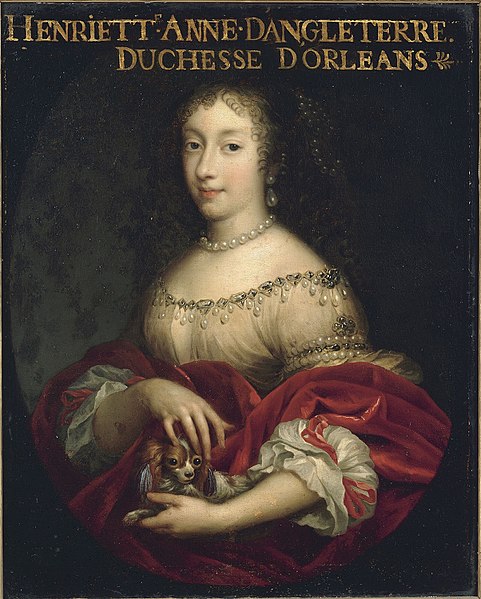
[…] the end of 1668, Louise obtained a position as maid of honor to Henriette-Anne, Duchess of Orléans, beloved sister of King Charles II of England. When Henriette-Anne, known as Minette or Madame, […]
LikeLike
[…] reading the letters of King Charles II to his sister Henrietta Anne, whom he called Minette, we get an in-depth glimpse into her personality. Not only that, there […]
LikeLike